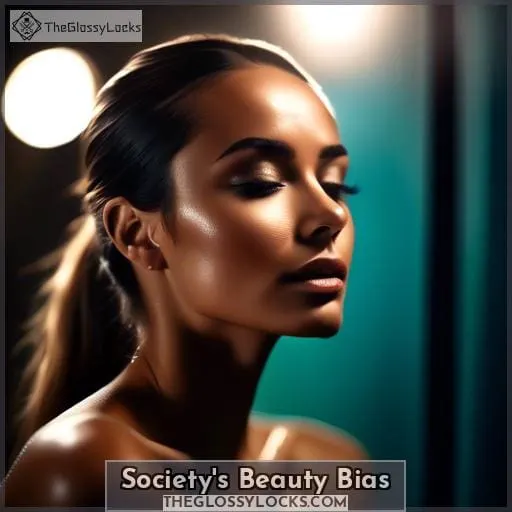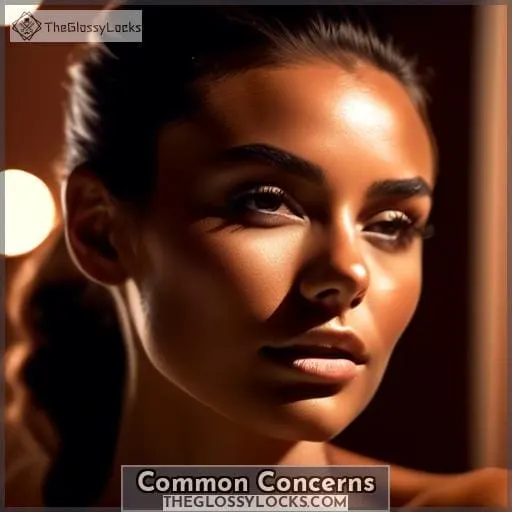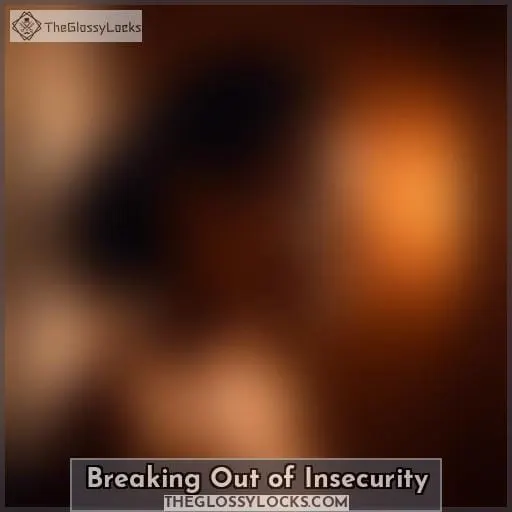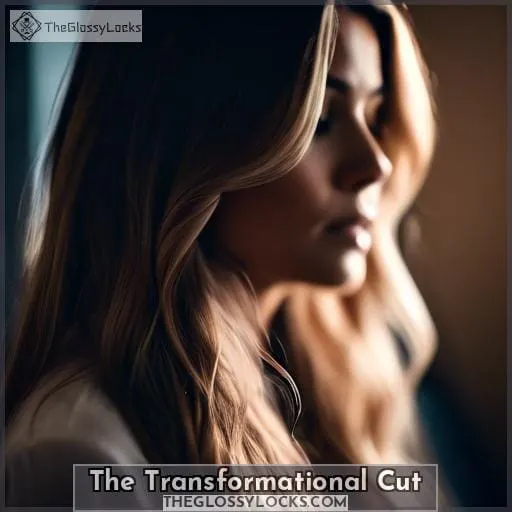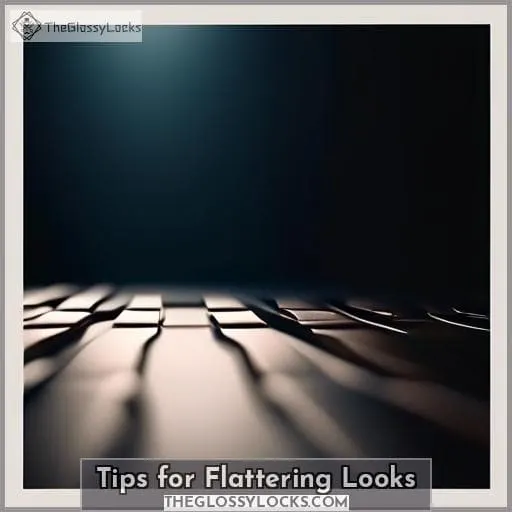This site is supported by our readers. We may earn a commission, at no cost to you, if you purchase through links.
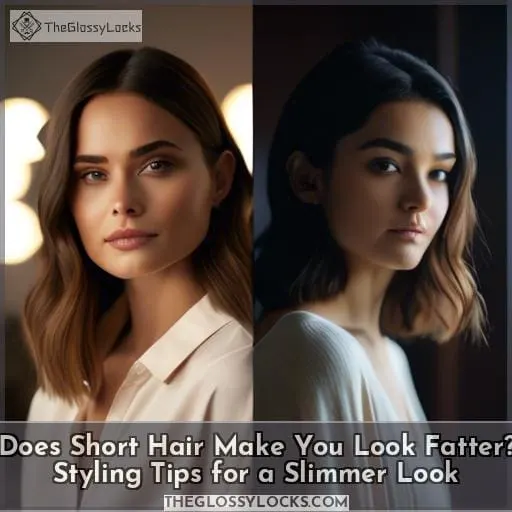
The truth is, the right haircut can sculpt your face, regardless of its length.
Whether you’re considering a bold chop or just curious, it’s all about finding the style that complements your unique features.
Embrace your shape and let’s dive into how to pick the perfect cut for a look that’s undeniably you.
No, short hair doesn’t inherently make you look fatter. The right hairstyle can actually make you appear thinner. For round faces, short hair with choppy strands, asymmetric side-parted styles, and angled bobs can help minimize width and create a more elongated look.
Layers and textured bangs can also help balance facial features. The key is to avoid adding volume to the sides and focus on creating volume on top or framing the face with layers (source: ).
Table Of Contents
- Society’s Beauty Bias
- Common Concerns
- Breaking Out of Insecurity
- The Transformational Cut
- Tips for Flattering Looks
- Frequently Asked Questions (FAQs)
- How does hair texture influence the perception of weight with short hairstyles?
- Can certain hair care products or styling techniques make short hair more flattering for fuller faces?
- What role does hair volume play in altering the perceived fullness of the face with short haircuts?
- How do cultural and personal identity factors affect the decision to choose short haircuts for individuals concerned about looking heavier?
- Are there specific short hairstyles recommended for people with certain facial features, such as a prominent nose or chin, to create a more balanced look?
- Conclusion
Society’s Beauty Bias
In the realm of beauty and personal style, the choice between short and long hair often intersects with societal attitudes towards body image and fatphobia. You might’ve encountered the pervasive belief that short hair accentuates facial roundness and body size, contributing to a fear of appearing fatter.
This notion, deeply rooted in societal beauty standards, suggests that longer hair can serve as a distraction or camouflage, potentially slimming one’s appearance. Such beliefs aren’t only influenced by media portrayals and stylist recommendations but also by personal insecurities and experiences, like the teenage haircut that unexpectedly heightened feelings of facial roundness.
These experiences underscore the complex relationship between hairstyle choices and body image, highlighting the need for a more inclusive understanding of beauty that celebrates diversity and challenges conventional norms.
Fatphobia and Hairstyles
While societal norms and beauty standards have long dictated that long hair is a symbol of femininity and attractiveness, thereby suggesting that short hair might make one appear less feminine or larger, it’s crucial to recognize that these perceptions are deeply rooted in fatphobia and the internalized belief that certain hairstyles aren’t suitable for everyone.
As you’re exploring the impact of fatphobia on hairstyles, it’s important to understand that this bias stems from a broader societal issue where media, hairstylists, and personal insecurities contribute to the perpetuation of these beliefs.
This not only influences the reluctance to adopt short hairstyles among individuals with larger body sizes due to fear of being perceived as larger but also highlights the need for a shift in how hairstyles are viewed in relation to body size and shape.
Teenage Haircut Experience
When did the belief that short hair isn’t suitable for those with fuller figures begin to shape our perceptions of beauty and self-worth?
- Inspired by Cassadee Pope, a razor-cut bob became a layered disappointment.
- The cut’s effect on facial roundness led to haircut devastation.
- A performance of satisfaction hid true feelings, masking the impact on self-esteem.
Common Concerns
You’ve likely heard the common concern: does short hair make you look heavier?
It’s a worry that can deter you from trying out a chic bob or pixie cut.
But here’s the truth: a haircut that’s tailored to your unique features can actually enhance your appearance, regardless of your body size.
Embracing a style that makes you feel confident is key to showcasing your personal flair and can shift the focus to your face and personal style rather than your body shape.
Prevalent Worries About Hair and Weight
As society grapples with deeply ingrained beauty standards, many individuals find themselves caught in a web of insecurities about how certain haircuts might impact their appearance in relation to weight.
You’re not alone in worrying that a style could seem unflattering; these prevalent concerns are fueled by societal norms that often narrowly define attractiveness.
However, personal style preferences need not be limited by cultural influences or body image worries.
Confidence can grow through thoughtful exploration of looks that make you feel your best.
Avoidance of Short Styles
You’ll often find yourself steering clear of short hairstyles due to the pervasive myth that they might accentuate fullness in your face.
- Cultural perceptions shape our hairstyle choices, often unfairly.
- Personal confidence can soar with the right, liberating cut.
- Hairstyle versatility is key to expressing individuality.
- Maintenance considerations are crucial; shorter styles can be simpler.
Breaking Out of Insecurity
You might have faced a moment where a drastic haircut, especially going shorter, wasn’t just a style choice but a necessity due to damage. This situation often brings fantasies of chic, short haircuts into sharp reality, challenging long-held insecurities about body image.
It’s a pivotal moment that can shift perceptions, proving that short hair doesn’t necessarily make you look fatter, but rather opens the door to embracing a new, confident self.
(Sources: The author’s own writing)
Forced Makeover After Damage
Facing a forced makeover after hair damage can feel like a daunting leap into the unknown, especially when you’re already grappling with insecurities about how your appearance might influence perceptions of your size.
Transitioning from worrying about the potential for a haircut to make you appear larger to embracing a new, shorter style requires a shift in perspective.
| Emotional Healing | Styling Alternatives |
|---|---|
| Damage Assessment | Product Selection |
| Gentle Handling | Flattering Cuts |
Acknowledging the damage and opting for a cut that not only addresses the health of your hair but also flatters your features can be a transformative experience. This step often involves breaking away from long-held beliefs about beauty and body size, challenging the internalized standards that dictate certain hairstyles are off-limits for those who don’t fit the conventional mold.
Fantasies Meet Reality
Emerging from the aftermath of a forced makeover due to bleach damage, you’re now confronted with the reality of your hair fantasies versus the insecurities they may mask.
Though cultural influences promote unrealistic beauty standards, personal acceptance allows self-expression freedom.
Experiment with hairstyles that boost confidence, not societal approval.
The Transformational Cut
The transformational cut represents a pivotal moment in embracing one’s true self, challenging deep-seated beliefs and societal norms that dictate appearance based on body type. This shift towards acceptance and confidence, despite initial reluctance, showcases the power of a haircut to redefine personal identity and break free from the constraints of fatphobia and insecurity.
Key points:
- Embracing authenticity is a journey of self-discovery and self-expression ().
- The transformative self is a self-identity that facilitates personal growth, cultivating a narrative identity towards a good life ().
- The body positivity movement challenges unrealistic beauty standards, normalizing all body types ().
- A good haircut can do wonders for confidence and self-esteem ().
- Personal identity and transformative experiences shape our future selves ().
- Challenging societal norms and fostering self-love are crucial for mental health ().
By embracing authenticity and challenging societal norms, individuals can redefine their personal identity and find strength in their differences, ultimately leading to empowerment and self-acceptance.
Stylist’s Interpretation
When you go for a significant haircut, the stylist’s interpretation of your request can sometimes lead to a transformational cut that may initially surprise you.
- Creative Interpretation – Embraces your unique features, enhancing personal style.
- Communication Challenges – Highlights the importance of clear expectations between you and your stylist.
- Emotional Impact – A fresh look can significantly boost confidence, fostering a deeper connection with your self-image.
Gradual Appreciation
Although initially hesitant to embrace the dramatic change, you’ll find that the journey towards appreciating a transformative haircut often begins with the first glimpse of your new look in the mirror.
This moment marks the start of an emotional journey, blending personal growth with a confidence boost.
As self-perception shifts, mirror avoidance fades, revealing a newfound appreciation for your bold choice.
Tips for Flattering Looks
When considering a change in hairstyle, it’s important to select one that flatters your features and potentially slims your appearance.
Face-framing layers can accentuate your cheekbones and jawline, creating a contouring effect that draws the eye vertically, giving the illusion of a slimmer face.
A side part adds asymmetry, which can break up the roundness of the face and contribute to a slimmer look.
Additionally, updos can elongate the face by drawing attention upwards, further enhancing a slimming effect.
These styling tips can help you feel more confident and embrace a look that celebrates your individuality.
Face-Framing Layers
After embracing the transformative power of a well-executed cut, you’ll find that adding face-framing layers can further refine your look, making your face appear longer and slimmer.
- Layering techniques: Experiment with varying lengths for a dynamic effect.
- Length considerations: Keep layers below the chin to elongate the face.
- Maintenance tips: Regular trims keep the shape flattering.
- Styling products: Use to enhance texture and volume.
- Hair texture: Tailor layers to complement your natural texture.
Side Parts and Volume
Embrace a side part to instantly add volume and create a more flattering silhouette, making your face appear slimmer and more defined.
| Emotion | Action |
|---|---|
| Empowerment | Use styling tools to lift roots, adding height. |
| Confidence | Apply volumizing products at the base. |
| Joy | Spritz texture-enhancing sprays for fullness. |
| Liberation | Master volumizing techniques for a bolder look. |
Updos for Slimming Effects
An up-do with intentional ‘flyaways’ can soften your facial features and create a slimming effect by drawing the eye upward.
- Feel the elegance of a chignon, lifting your confidence as it elongates your profile.
- Embrace a braided crown, circling your head with grace and defying gravity.
- Opt for a sleek ponytail, a simple yet powerful statement of control.
- Revel in a textured bun, showcasing sophistication while subtly slimming.
- Adorn with a twisted halo, a symbol of understanding and self-acceptance.
Frequently Asked Questions (FAQs)
How does hair texture influence the perception of weight with short hairstyles?
Your hair’s texture can affect how full or slim your face appears with short styles.
Fine hair may need layers for volume.
While thick hair benefits from weight-reducing cuts to avoid a bulky look.
Can certain hair care products or styling techniques make short hair more flattering for fuller faces?
Certainly, using the right hair care products and styling techniques can enhance short hairstyles for fuller faces.
Opt for volumizing sprays or mousses to add lift at the roots, creating the illusion of a slimmer face.
Texturizing products can also define layers and add movement, drawing attention away from the face’s roundness.
What role does hair volume play in altering the perceived fullness of the face with short haircuts?
With short haircuts, strategically placed volume can elongate your face and create a slimming effect.
It’s key to add height at the crown rather than the sides to avoid widening your face.
How do cultural and personal identity factors affect the decision to choose short haircuts for individuals concerned about looking heavier?
Cultural and personal identity factors heavily influence short haircut choices, as they’re entwined with self-expression and challenging societal norms. You’re not just cutting hair; you’re defining your identity and defying fatphobic stereotypes.
Cultural and personal identity factors heavily influence short haircut choices, as they’re entwined with self-expression and challenging societal norms.
You’re not just cutting hair; you’re defining your identity and defying fatphobic stereotypes.
Are there specific short hairstyles recommended for people with certain facial features, such as a prominent nose or chin, to create a more balanced look?
For those with prominent noses or chins, asymmetrical bobs, textured pixie cuts, and layered styles with side-swept bangs can create a harmonious balance.
These cuts draw attention to your best features, offering a fresh, confident look.
Conclusion
The journey to finding your perfect hairstyle might feel daunting, but it’s also an opportunity to challenge societal norms and embrace your individual beauty.
With the right cut, tailored to your unique features, you can highlight your best assets. Whether it’s through face-framing layers, strategic side parts, or voluminous updos, the secret lies in choosing a style that makes you feel confident and radiant.

